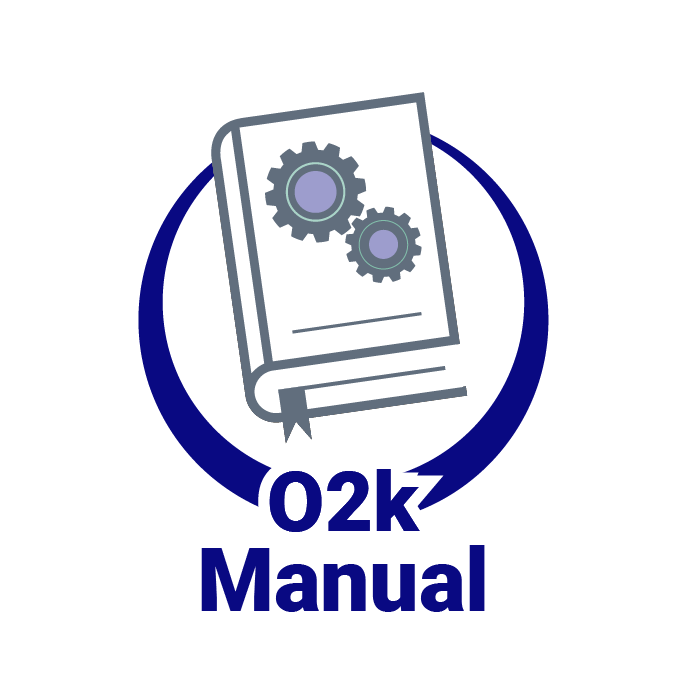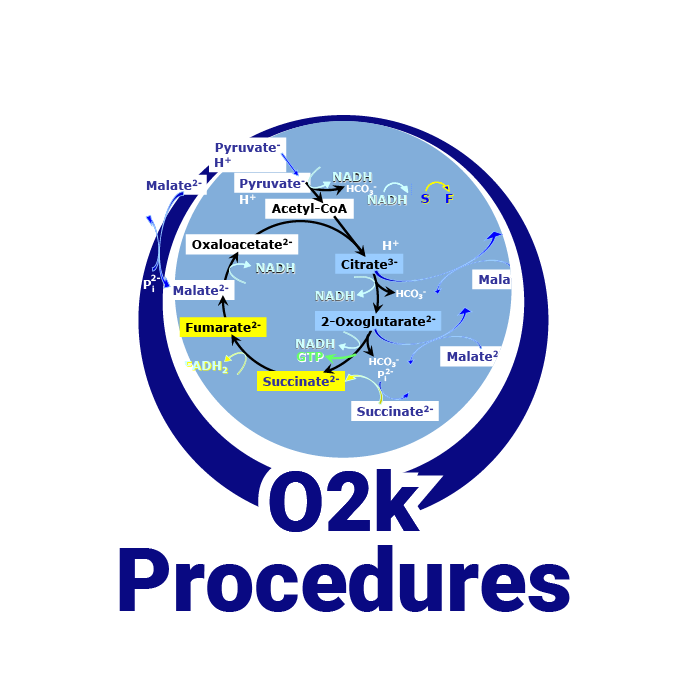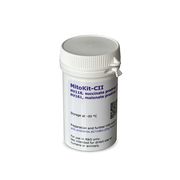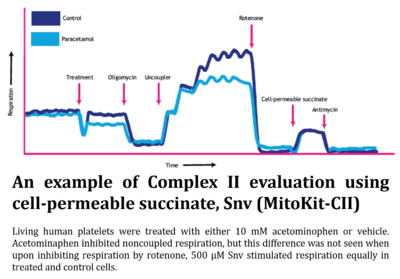 |
MitoKit-CII |
MitoPedia O2k and high-resolution respirometry:
O2k-Open Support
Description
Cell permeable prodrugs, composed of MitoKit-CII/Succinate-nv and MitoKit-CII/Malonate-nv, stimulates (Snv) or inhibits (Mnanv) mitochondrial respiration in CI-deficient human blood cells, fibroblasts and heart fibres, acting on Complex II of the electron transfer system.
Reference: Product details and purchasing information
- A joint publication is planned, which will summarize the scientific results and experience with the MitoKit-CII compounds, and specifically explain the new SUIT-protocols and limitations of application of the MitoKit-CII compounds.
- Coauthors (alphabetical, preliminary): Aasander Frostner E, Doerrier C, Ehinger JK, Elmer E, Garcia-Souza LF, Gnaiger E, Hansson MJ, Meszaros A
Additional resources
Specific SUIT protocols
- DL-Protocols D060 and D050
- SUIT-003_O2_ce_D060 for living cells using MitoKit-CII/Succinate-nv and MitoKit-CII/Malonate-nv.
- SUIT-003_O2_ce_D050 for living cells using MitoKit-CII/Succinate-nv.
- DL-Protocols D060 and D050
Application in HRR
- » Download poster: Frostner et al (2017)
Preparation
- Both compounds are dissolved in DMSO and stored up to 1 week at room temperature or up to 4 months for MitoKit-CII/Succinate-nv and up to 6 months for MitoKit-CII/Malonate-nv at -20 °C.
- We recommend the following dilutions for reaching the desired concentration in the experiments:
- MitoKit-CII/Succinate-nv: 100 mM stock solution
- MitoKit-CII/Malonate-nv: 10 mM stock solution
Limitations
- General: all prodrugs (Snv and Mnanv) have some limitations:
- Possibility for variable cell penetration through the plasma membrane of living cells in different cell types.
- Possibility for limitation in the speed of intracellular release.
- Possibility for prodrug molecule toxicity.
- Possibility for prodrug byproduct toxicity.
- Depending on the release mechanism - the possibility of ATP requirements or other cellular depletion caused by prodrug metabolism.
- General: all prodrugs (Snv and Mnanv) have some limitations:
- Specific
- Snv (NV118) and Mnanv (NV161) exert inhibitory effects on mitochondrial respiration at high concentrations, particularly >1 mM, other than the specific inhibition of CII by Mnanv after intracellular release. At Oroboros we observed inhibition of respiration in permeabilized cells by both prodrugs, and inhibition of isolated mouse heart mitochondria by Mnanv. Therefore, do not use concentrations >500 µM in respiratory assays, and always consider potentially inhibitory side effects.
- Snv and Mnanv are plasma unstable. This will likely be the case for all prodrugs of succinate that will be suitable for in vitro use. The experience at Abliva is that very plasma stable prodrugs release succinate very slowly intracellularly.
- In addition, at Abliva we have recently experienced another issue that could affect the use of these prodrugs in a rotenone-induced lactate assay and we suggest formulating the limitation for Snv this way: "Snv is a prodrug of succinate for in vitro use with the main application to deliver succinate to living cells in respiratory (oxygen consumption) protocols. Upon intracellular prodrug hydrolysis, formaldehyde is released which, at high concentration, has an inhibitory effect on glycolysis (Tiffert et al 1984). For in vitro experiments dependent on glycolysis and lactate production as an output measure, Snv should be carefully titrated to improve mitochondrial respiration without inhibiting glycolysis, which could be evidenced by restored lactate production following downstream (of CII) inhibition of the electron transfer system (using antimycin A).”
- Specific
SUITbrowser question: Permeable succinate/malonate
- The cell permeable prodrugs Succinate-nv and Malonate-nv can help to answer questions related to the S-pathway in living cells. Use the SUITbrowser to find the best protocol to answer this and other research questions.
References
| Link | View | Reference | Year |
|---|---|---|---|
| Avram 2021 Int J Mol Sci | PMID: 33401621 Open Access » | Avram VF, Chamkha I, Åsander-Frostner E, Ehinger JK, Timar RZ, Hansson MJ, Muntean DM, Elmér E (2021) Cell-permeable succinate rescues mitochondrial respiration in cellular models of statin toxicity. Int J Mol Sci 22:424. | 2021 |
| Piel 2020 PLoS One | PMID: 32251487 Open Access | Piel S, Chamkha I, Dehlin AK, Ehinger JK, Sjövall F, Elmér E, Hansson MJ (2020) Cell-permeable succinate prodrugs rescue mitochondrial respiration in cellular models of acute acetaminophen overdose. PLoS One 15:e0231173. | 2020 |
| Owiredu 2020 Am J Physiol Cell Physiol | PMID: 32374677 | Owiredu S, Ranganathan A, Eckmann DM, Shofer FS, Hardy K, Lambert DS, Kelly M, Jang DH (2020) Ex vivo use of cell-permeable succinate prodrug attenuates mitochondrial dysfunction in blood cells obtained from carbon monoxide poisoned individuals. Am J Physiol Cell Physiol 319:C129-35. | 2020 |
| Owiredu 2020 Toxicol Rep | Open Access | Owiredu S, Ranganathan A, Greenwood JC, Piel S, Janowska JI, Eckmann DM, Kelly M, Ehinger JK, Kilbaugh TJ, Jang DH (2020) In vitro comparison of hydroxocobalamin (B12a) and the mitochondrial directed therapy by a succinate prodrug in a cellular model of cyanide poisoning. Toxicol Rep 7:1263-71. | 2020 |
| Janowska 2020 Toxicol In Vitro | PMID: 32057835 Open Access | Janowska JI, Piel S, Saliba N, Kim CD, Jang DH, Karlsson M, Kilbaugh TJ, Ehinger JK (2020) Mitochondrial respiratory chain Complex I dysfunction induced by N-methyl carbamate ex vivo can be alleviated with a cell-permeable succinate prodrug carbamate toxicity and treatment. Toxicol In Vitro 65:104794. | 2020 |
| Ehinger 2016 Nat Commun | PMID: 27502960 Open Access » | Ehinger JK, Piel S, Ford R, Karlsson M, Sjövall F, Frostner EÅ, Morota S, Taylor RW, Turnbull DM, Cornell C, Moss SJ, Metzsch C, Hansson MJ, Fliri H, Elmér E (2016) Cell-permeable succinate prodrugs bypass mitochondrial Complex I deficiency. Nat Commun 7:12317. https://doi.org/10.1038/ncomms12317 | 2016 |
Labels: MiParea: Instruments;methods
HRR: O2k-Protocol
O2k-chemicals and media
MitoPedia O2k and high-resolution respirometry:
O2k-Open Support,
O2k-Respirometry,
O2k-FluoRespirometry
MitoPedia topics:
Inhibitor,
Substrate and metabolite






